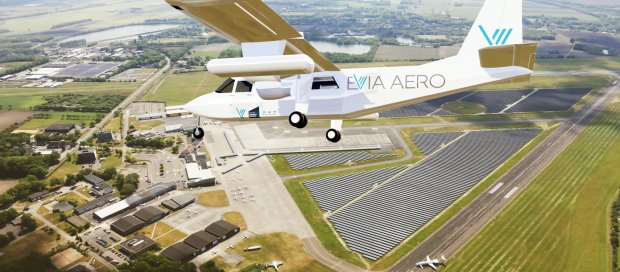No Shortcuts In Evia Aero's Path To Being Europe's First Green Regional Airline
 Credit: Cranfield Aerospace Solutions
Credit: Cranfield Aerospace Solutions
Charles Alcock / March 10, 2023
The closer you examine the task of establishing a green airline, the clearer it becomes that it does not begin and end with sourcing net zero carbon aircraft. Evia Aero is a case in point in that while the German start-up has made provisional commitments to a pair of electric aircraft developers, for now, it is more preoccupied with getting a somewhat daunting operational ecosystem in place.
“First you have to be sure that you can operate as a truly sustainable aviation company,” Evia Aero founder Florian Kruse told FutureFlight. The Bremen-based venture plans to invest in photovoltaic (PV) solar energy plants at the airports it intends to serve to fulfill its commitment to being self-sufficient in green energy, which could include electricity and hydrogen fuel. The next step will be installing the required refueling and recharging facilities.
Only when these tasks are well advanced, probably in 2024, will Evia Aero secure the air operator certificate it needs to launch commercial scheduled services in Europe. The company has yet to determine whether it will establish an operation from scratch or acquire an existing AOC holder.
“Some people ask us why we don’t just start operating normal [fossil-fuel-burning] aircraft today and then make a transition [to net zero],” Kruse noted. “But we don’t think that works. The only way to be successful in this is to be green with everything from the start.”
In this regard, Evia Aero’s strategy isn’t based purely on a sustainability agenda. It views the plans for refueling and maintenance as key parts of its revenue stream, over and above earnings from selling flights to passengers it believes will pay a premium to access airfields in locations across northern Europe that are not well served by road and rail links.
Evia Aero is not without expertise as it seeks to put these building blocks in place. One of its backers, Energiequelle, is involved in a business that owns and operates PV plants in Finland and Germany. Its leadership team also includes Gerd Weber, CEO of regional airline OLT, and the chair of its advisory board is Axel Trampnau, who previously ran the carrier Germania.
HYDROGEN-POWERED ISLANDERS AND ALL-ELECTRIC ALICE IN THE PICTURE
Under current plans, the first aircraft in the Evia Aero flight will be nine-passenger Britten-Norman Islanders under a plan being advanced by Cranfield Aerospace Solutions (CAeS) to convert the piston-powered models to hydrogen propulsion. Evia Aero expects these aircraft to be ready to enter service in 2026 and has agreed to buy 15 of the conversion kits.
In 2022, the new airline signed a wider agreement with CAeS covering a provisional order for 10 hydrogen-powered 19-seat aircraft. The companies have not yet determined whether these would be conversions of existing aircraft or a clean-sheet design. Under the UK’s Project Fresson, CAeS is working on plans for new 19- and 75-seat zero-emissions regional airliners.
Separately, Evia Aero has signed a memorandum of understanding covering provisional orders for 25 of Eviation’s nine-passenger, all-electric Alice aircraft. It expects to add the first of these to its fleet in 2028, a year after the U.S.-based manufacturer now says it aims to complete type certification, initially with the FAA.
A technology demonstrator of the Alice made its first flight in September 2022 but has not taken off since. A spokesman for Eviation told FutureFlight that the company is analyzing data from the first flight "to refine the test program and optimize the design for large-scale manufacturing."
With either of these aircraft, Evia Aero will be launching its services with the equipment providing a modest payload and range. The Cranfield Islanders will be able to fly up to around 200 kilometers (109 nm), while Eviation last year reduced its range projections from 440 to 250 nm, citing the limitations of current battery technology.
Kruse accepts these limitations, while already laying plans to add subsequent 19-seat aircraft to his fleet. He showed FutureFlight route maps for both aircraft including planned destinations extending along the North Sea and Channel coasts from Denmark through Germany and the Benelux countries and into France and the UK.
Both the Islander and the Alice offer short takeoff and landing performance that will allow them to get in and out via limited runways in small communities. In the case of the Islander, which has been in service for several decades, it will even be able to operate from grass landing strips.
“Regional economies need connectivity and short-haul flights with aircraft like these make this possible,” said Kruse. He expects the new airline to carry everyone from offshore wind farm engineers to maritime lawyers needing to make convenient trips between the ports of Bremen and Copenhagen. Other possible stops on the planned network could include the Belgian city of Antwerp and the Dutch port cities of Groningen and Rotterdam.
Evia Aero, which Kruse said is already in talks with as many as 30 regional airports about possible air services, is also eyeing the Nordic countries, the UK’s islands, and parts of southern Germany as target markets. Norway with its mountainous coastline seems a promising early adopter for short flights in net zero aircraft, not least because the country’s government plans to ban conventional aircraft on domestic routes from 2030.
The investment required for this green air transport plan to be economically viable is not insubstantial, and Evia Aero is seeking to raise further funding. For instance, it projects the cost of setting up a 10-megawatt solar energy plant at around €12.5 million ($13.2 million).
“We have to take the long-term view and be able to survive and prepare for the time when we will have aircraft in service,” said Kruse. In his view, launching services with small aircraft reduces risk because their operational break-even costs will be lower, especially based on the expectation of lower maintenance costs based on the propulsion systems having far fewer parts.


